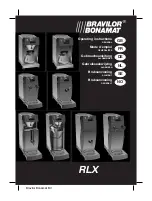
EN
TIG 185 DC. Operating manual.
TIG 185 DC. Operating manual.
21
20
Problem
Porosity in weld
deposit
Cracking in welds
Inadequate shielding
Arc blow
Short parts life
Cause
Entrapped impurities, hydrogen, air, nitrogen, water vapour
Defective gas hose or loose connection
Filler material is damp (particularly aluminium)
Filler material is oily or dusty
Alloy impurities in the base metal such as sulfur,
phosphorous, lead and zinc
Excessive travel speed with rapid freezing of weld trapping
gases before they escape
Contaminated shield gas
Hot cracking in heavy section or with metals which are hot
shorts
Crater cracks due to improperly breaking the arc or
terminating the weld at the joint edge
Post weld cold cracking due to excessive joint restraint,
rapid cooling or hydrogen embrittlement
Centreline cracks in single pass weld
Underbead cracking from brittle microstructure
Gas flow blockage or leak in hoses or torch
Excessive travel speed exposes molten weld to atmospheric
contamination
Wind or drafts
Excessive electrode stickout
Excessive turbulence in gas stream
Induced magnetic field from DC weld current
Arc is unstable due to magnetic influence
Cup shattering or cracking in use
Short collet life
Short torch head life
Solution
Do not weld on wet material. Remove condensation from
line with adequate gas pre-flow time
Check hoses and connections for leaks
Dry filler metal in oven prior to welding
Replace filler metal
Change to a different alloy composition which is weldable.
These impurities can cause a tendency to crack when hot
Lower the travel speed
Replace the shielding gas
Preheat. Increase weld bead cross-section size. Change weld
bead contour. Use metal with fewer alloy impurities
Reverse direction and weld back into previous weld at edge.
Use Amprak or foot control to manually downslope current
Preheat prior to welding. Use pure or non-contaminated gas.
Increase the bead size. Prevent craters or notches. Change
the weld joint design
Increase bead size. Decrease root opening.
Use preheat. Prevent craters
Eliminate sources of hydrogen, joint restraint
and use preheat
Locate and eliminate the blockage or leak
Use slower travel speed or carefully increase the flow rate
to a safe level below creating excessive turbulence. Use a
trailing shield cup
Set up screens around the weld area
Reduce electrode stickout. Use a larger size cup
Change to gas safer parts or gas lens parts
Rearrange the split ground connection
Reduce weld current and use arc length as short as possible
Change cup size or type. Change tungsten position
Ordinary style is split and twists or jams
Change to wedge style
Do not operate beyond rated capacity. Use water cooled
model. Do not bend rigid torches
9. Periodic maintenance.
WARNING
Only authorised electricians should carry out repairs and internal
servicing.
Modification of the primary input plug or fitment of a lower rated
primary input plug will render the warranty null and void.
The working environment or amount of use the machine receives should
be taken into consideration when the planning maintenance frequency
of your system.
Preventative maintenance will ensure trouble-free welding and increase
the life of the machine and its consumables.
9.1 Daily maintenance
Perform the following maintenance daily:
→ Clean the electrode holder and TIG torch‘s gas nozzle. Replace
damaged or worn parts.
→ Check the TIG torch‘s electrode. Replace or sharpen, if necessary.
→ Check the tightness of welding and earth cable connections.
→ Check the condition of mains and welding cables and replace
damaged cables.
→ See that there is enough space in front of and back of the unit for
ventilation.
9.2 Regular power source maintenance
→ Check the electrical connections of the unit at least twice a year.
→ Clean oxidised connections and tighten.
→ Inner parts of the machine should be cleaned with a vacuum cleaner
and soft brush.
→ Do not use any pressure-washing devices.
→ Do not use compressed air as pressure may pack dirt even more
tightly into components.
Содержание TIG 185 DC
Страница 1: ...TIG 185 DC Operating Manual ...































